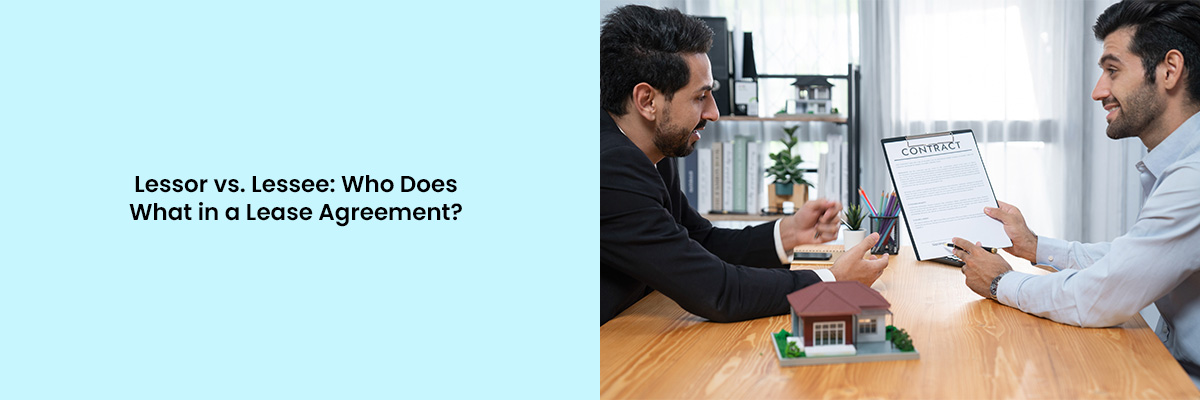Agreements don’t just pop out of nowhere, they’re made between two parties: one who sets the terms, and the other who accepts them. In leasing, those terms are usually about using something valuable, like a piece of land, a building, or equipment, for a set period of time. One party receives money, the other gets the right to use the item, and both have clearly defined roles and responsibilities.
In a rental setting, the leased object becomes a house, apartment, or commercial space. The person offering the property decides how it’s to be used, how long the lease lasts, and how much it will cost. The person accepting those terms agrees to follow them in exchange for the right to use the space.
In this blog, we’ll break down what exactly a lessor and a lessee are, what sets them apart, and what roles each plays in a lease agreement. Then we’ll go inside the lease agreement itself to explore what it includes, how responsibilities are divided, and how everything is laid out for clarity and protection.



Lessor vs. Lessee: The Basics
At the heart of any lease agreement are two players:
1. Lessor: The Owner or Landlord
The lessor is the individual or entity that owns the property or asset and agrees to let someone else use it in exchange for payment. In rental housing, the lessor is usually the landlord or property manager.
Key Responsibilities and Rights of the Lessor:
- Sets the lease terms, including rent amount, lease duration, deposit, etc.
- Provides a habitable, safe property that meets legal and building standards.
- Maintains the structure, such as roofing, plumbing, electrical, and other major systems.
- Collects rent and handles financial agreements related to the lease.
- Holds the right to terminate the lease if the lessee violates terms (with proper notice).
- Handles legal obligations such as taxes, insurance, and local compliance requirements.
The lessor’s goal is to protect their property, earn income from it, and ensure it is used lawfully and responsibly.
2. Lessee: The Tenant or User
The lessee is the person or entity that receives the right to use the lessor’s property under the agreed terms. In a rental lease, this is the tenant.
Key Responsibilities and Rights of the Lessee:
- Pays rent on time as agreed in the lease.
- Follows all lease terms, including rules about pets, noise, maintenance, subleasing, etc.
- Takes care of the property, not in the same way an owner would, but keeps it clean and avoids damage.
- Report maintenance issues to the landlord so they can be addressed properly.
- May have rights to renew or terminate the lease, depending on how the agreement is written.
- Has a legal right to privacy and peaceful enjoyment of the rented premises.
The lessee’s interest lies in using the property without ownership while having the legal protection and usability promised in the lease.
What’s in a Lease Agreement?
A lease agreement isn’t there to impress, it’s there to protect. For landlords, property managers, and tenants alike, it spells out every rule, expectation, and consequence tied to renting a property. The more clear and thorough it is, the fewer headaches you’ll have later. Every clause has a purpose, whether it’s to cover liability, avoid disputes, or simply keep things organized.
Here’s what a well-drafted U.S. residential lease should include:
1. Names & Contact Details
Before anything else, a lease needs to identify the people involved. This section ensures there’s no confusion about who’s legally responsible.
- Full legal names of all tenants (lessees) and the landlord or property manager (lessor)
- Current mailing addresses (especially the landlord’s, for notices)
- Phone numbers and email addresses for both parties
- Emergency contact for tenant(s) in case of fire, flood, or emergency repair
2. Property Description
This section defines the actual space being leased. No guesswork.
- Full rental property address, including unit or apartment number
- ZIP code and possibly county or subdivision name
- Any included features or amenities, such as:
- Designated parking spots
- Storage units or lockers
- Access to common/shared spaces (e.g., gym, laundry room)
- Use of garage, yard, or patio
If the unit is part of a multi-family building, the lease should also reference that to eliminate ambiguity.
3. Lease Term
Here we get into the duration of the lease, when it begins and when it ends.
- Start and end dates of the agreement
- Whether it’s a fixed-term lease (usually 12 months) or a month-to-month tenancy
- Details about automatic renewals, if applicable
- Required notice period for non-renewal or termination (typically 30 or 60 days)
- Conditions under which either party can terminate early (e.g., military deployment, sale of property)
4. Rent Terms
Arguably the most important part, who pays how much, and when.
- Monthly rent amount
- Due date (usually the 1st of each month)
- Accepted payment methods (check, bank transfer, online payment platform)
- Late fees:
- Grace period (usually 3-5 days)
- Specific late fee amount or daily charges for overdue payments
- Bounced check fee or returned payment penalties.
5. Security Deposit
This section protects both parties. The tenant is encouraged to care for the property, and the landlord has a way to cover unpaid rent or damages.
- Exact amount of the security deposit
- Due date for payment (usually at lease signing or before move-in)
- Conditions under which deductions can be made (e.g., unpaid rent, damages beyond normal wear)
- Timeframe for returning deposit (state-specific, often 14 to 30 days after move-out)
- Interest on the deposit, if required by state law.
6. Use of the Property
Tenants need to know the do’s and don’ts. This section defines acceptable use.
- Residential use only (unless permission is granted for a home-based business)
- Subleasing rules (prohibited without written consent in most cases)
- Guest limitations (how long visitors can stay before they’re considered occupants)
- Smoking policy: banned, outside only, or allowed with restrictions
- Pet policy:
- Whether pets are allowed
- Pet deposits or monthly fees
- Breed or weight restrictions (e.g., no large dogs, no exotic animals)
7. Maintenance & Repairs
Preventing and resolving maintenance issues starts with clear roles.
- Landlord’s responsibilities:
- Structural repairs
- HVAC, plumbing, and electrical systems
- Pest control (unless caused by tenant negligence)
To read in detail about Do Landlords Have to Clean Between Tenants?, do give our in-depth blog a read.
- Tenant’s responsibilities:
- Routine upkeep (cleaning, trash removal)
- Replacing light bulbs, batteries, and filters
- Reporting issues promptly
- How to report maintenance requests (phone, online portal, etc.)
- Standard response time expectations
To read in detail about Can a landlord evict a tenant for damaging property?, do give our in-depth blog a read.
8. Utilities & Services
This is often where confusion or disputes arise. Spell it out.
- Utilities included in rent:
- Water, sewer, trash collection, gas (if any)
- Water, sewer, trash collection, gas (if any)
- Utilities the tenant must pay directly:
- Electricity
- Internet/cable
- Heating oil, if used
- Optional services and who is responsible:
- Lawn care or snow removal
- Pest control contracts
9. Right of Entry
Landlords have a right to access their property, but tenants also have a right to privacy.
- Required notice period by Landlord before entry (usually 24 hours)
- Acceptable reasons for entry:
- Repairs or maintenance
- Property showings to prospective tenants or buyers
- Emergencies (no notice required)
- Form of notice (written, email, text)
10. Legal Disclosures
Failure to include legally mandated disclosures can lead to penalties or lawsuits.
- Lead-based paint disclosure (required for properties built before 1978)
- Disclosure of known mold issues, asbestos, or flood zone status (depending on local laws)
- Summary of tenant rights (in jurisdictions with rent control or additional protections)
11. Default, Breach, and Termination
This section details what happens when things go wrong.
- What constitutes a breach (e.g., non-payment, illegal activity, unauthorized occupants)
- Steps required before termination (usually written notice and time to fix the issue)
- Legal remedies available to the landlord
- Grounds for eviction
- Consequences for early termination (e.g., losing deposit, paying remainder of lease)
12. Signatures & Execution
It’s not enforceable until it’s signed.
- Signatures of all adult tenants
- Signature of the landlord or authorized property manager
- Date of execution
- Optional: witness signature or notary (not common but used in some areas for extra protection)
With all these components, a lease agreement serves as the rulebook and reference point for the entire rental period. The more comprehensive and clear it is, the less room there is for confusion or conflict. Landlords and property managers should review their leases regularly to ensure they’re compliant with current laws and tailored to their specific property needs.
To read in detail about Lease Extension vs. Lease Renewal, do give our in-depth blog a read.
Conclusion: Understanding Who Does What in a Lease Agreement
While a lease agreement might seem like paperwork on the surface, it’s really the backbone of every rental relationship. The dynamic between a lessor and a lessee isn’t just about who owns what or who pays whom, it’s about clarity, accountability, and legal structure. Without a solid lease, misunderstandings aren’t just possible, they’re inevitable.
For landlords and property managers in the U.S., especially in today’s increasingly regulated rental environment, a well-crafted lease does more than protect your property, it protects your business. And for tenants, it’s a safeguard for their rights, their peace of mind, and their home life. Knowing who does what, and having it in writing, isn’t optional. It’s essential.
Whether you’re drafting your first lease or reviewing an old one, look at it not as a formality, but as a tool. When both sides understand their roles, rights, and responsibilities, the lease stops being a point of tension and starts being what it should be: a shared agreement that works for everyone involved.
For expert-led Property Management Training, check out our property management training webinars to stay informed and inspired.


